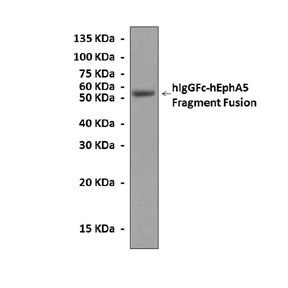Anti-EphA5: Mouse EphA5 Antibody |
 |
BACKGROUND Eph family of receptor tyrosine kinases consists of at least 14 distinct receptors and has eight membrane-bound ligands, known as the ephrins. This is the largest family of receptor tyrosine kinases. Eph proteins are divided into two subfamilies: the EphA receptors (A1-A8) that bind glycosyl phosphatidylinositol (GPI)-linked ephrin-A ligands (A1-A5), and the EphB receptors (B1-B6) that bind transmembrane ephrin-B ligands (B1-B3). The only known crosstalk between the A and B subfamilies occurs with the EphA4 receptor, which can bind ephrins-B2 and -B3 as well as the entire A subclass. There is a great deal of redundancy of receptor-ligand binding specificity within each subfamily, although binding affinities vary.1,2 Both GPI-anchoredephrinA and transmembrane ephrinB ligands interact with the Nterminal globular domain (Glob) of Eph receptors. The Eph receptors become phosphorylated at specific tyrosine residues in the cytoplasmic domain following ligand binding. Phosphorylated motifs serve as sites of interaction with certain cytoplasmic signaling proteins to mediate downstream signaling. In addition, through their C terminus the Eph receptors associate with PDZ (postsynaptic density protein, disc large, zona occludens) domain-containing proteins. Moreover, Eph receptor contact induces tyrosine phosphorylation of the cytoplasmic domain of ephrinB proteins via an SRC-family kinase (SFK), which mediating the reverse signaling. One of the unique features of Eph/ephrin signaling is the fact that both receptors and ligands are competent to transduce a signaling cascade upon interaction. Eph-activated signaling is termed forward, and ephrin-activated signaling is termed reverse. Another level of complexity stems from the fact that interactions between Eph receptors and ephrins can happen in trans (between two opposing cells) or in cis (within the same cell). It is commonly assumed that trans interactions are activating while cis interactions are inhibiting.3 Eph-Ephrin signaling functions in a variety biological processes including diverse assegmentation of the somites and rhombomeres, the formation of blood vessels, Axon guidance and fasciculation, migration of the neural crest and metastasis of transformed cells etc.
EphA5 mediates the effects of Ephrin-A5 and related ligands. EphA5 receptors are expressed almost exclusively in the nervous system, especially in the limbic structures. Recent studies suggest EphA5 to be important in the topographic projection, development, and plasticity of limbic structures, and to be involved in dopaminergic neurotransmission, the guidance of retinal, cortical, and hippocampal axons during development. The continued expression of EphA5 in the adult brain, in particular in areas associated with a high degree of synaptic plasticity such as the hippocampus, implicated its function in the mature nervous system. EphA5 activation is recruited in the LTP induced by tetanization.4 EphA5 receptor may be involved in mediation of aggressive behavior regulated, in part, by hypothalamic serotonin.5
REFERENCES
1. Brantley-Sieders, D.M. & Chen, J.: Angiogenesis. 7:17, 2004
2. Murai, K.K. & Pasquale, E.B.: J. Cell Sci. 116:2823, 2003
3. Arvanitis, D. & Davy, A.: Genes & Dev. 22:416, 2008
4. Gao, W.Q et al: Mol. Cell Neurosci.11:247-59, 1998
5. Mamiya, P.C. et al: Brain Res. 1205:91-9, 2008
2. Murai, K.K. & Pasquale, E.B.: J. Cell Sci. 116:2823, 2003
3. Arvanitis, D. & Davy, A.: Genes & Dev. 22:416, 2008
4. Gao, W.Q et al: Mol. Cell Neurosci.11:247-59, 1998
5. Mamiya, P.C. et al: Brain Res. 1205:91-9, 2008
Products are for research use only. They are not intended for human, animal, or diagnostic applications.
Параметры
Cat.No.: | CP10081 |
Antigen: | Purified recombinant human EphA5 fragments expressed in E. coli. |
Isotype: | Mouse IgG |
Species & predicted species cross- reactivity ( ): | Human |
Applications & Suggested starting dilutions:* | WB 1:1000 IP n/d IHC n/d ICC n/d FACS n/d |
Predicted Molecular Weight of protein: | 130 kDa |
Specificity/Sensitivity: | Detects overexpressed EphA5 proteins in cells without cross-reactivity with other family members. |
Storage: | Store at -20°C, 4°C for frequent use. Avoid repeated freeze-thaw cycles. |
*Optimal working dilutions must be determined by end user.
Документы
Информация представлена исключительно в ознакомительных целях и ни при каких условиях не является публичной офертой








